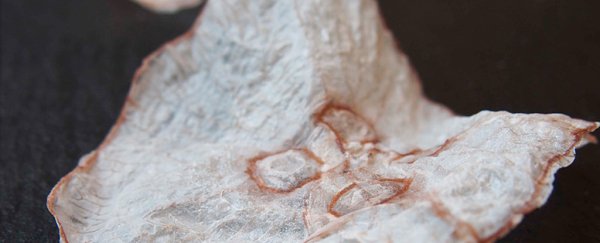If you're a fan of potato chips, the next best thing might just be a crispy, lightweight sheet of preserved jellyfish.
Scientists have come up with a new way to prepare these animals for consumption, improving on a centuries-old technique. And they say that eating these creatures would both help us battle jellyfish blooms in certain parts of the world, and diversify our food chain.
In China, jellyfish from the Rhizostomae order have been consumed for more than 1,700 years, and you can find them in salads and soups in many Southeast Asian countries - but the practice has never really caught on in the west.
Now researchers in Denmark have come up with a new way to prepare these animals for consumption, and hope that the dried-out final product might entice appetites way beyond Asia.
Considering that the world's growing population is in urgent need of diversifying our food sources, we suppose it's worth hearing these researchers out.
Typically, a jellyfish aimed for your plate is caught fresh and immediately - while still alive - steeped in a specialised mixture of table salt and alum, a potassium-aluminium compound commonly used in leather tanning and baking powder.
Over the course of a month, the steeping process goes through multiple steps as the treatment reduces the water content of the jellyfish, preserving it and rendering it into a somewhat rubbery, chewy product.
Most recipes for the steeping liquid are a trade secret, and the chemistry behind the process is not well understood, so a team led by gastrophysicist Mie Thorborg Pedersen from the University of Southern Denmark ran some experiments to investigate.
They collected a bunch of Aurelia aurita jellyfish along the Danish coast and subjected them to several preparation techniques - both a traditional Chinese method they found in the literature, and other solutions they thought might work based on the cellular composition of the creatures.
The researchers discovered that when the jellyfish are immersed in 96 percent ethanol, they dry up in just a few days, producing a papery, crunchy treat once the alcohol evaporates away.
"In the course of a couple of days, the alcohol replaces the water in the jellyfish. In the subsequent evaporation process they become bone dry," says Thorborg Pedersen.
"The mouth feel and the aesthetic appearance in particular have gastronomic potential."
The team thinks that the method could be appealing at a commercial level both because of its efficiency and the fact that there's no need to use aluminium salts. But since the end-product is different from the delicacy as it's commonly found in Asia, it probably won't replace the centuries-old techniques in favour there.
But the researchers are more interested in enticing the locals, which is also why they experimented on A. aurita - this species is becoming invasive in Nordic regions such as the Baltic Sea, and some think that eating the animals might be a good way to tackle this ecological problem.
The scientists haven't elaborated on what the nutritional value would be of their crispy invention, but say their discovery calls for "new gastronomical developments".
So… we guess you can watch this space? We'll let you know if we ever hear about packets of Aurita crisps lining the shelves in Denmark.
The study was published in the International Journal of Gastronomy and Food Science.
